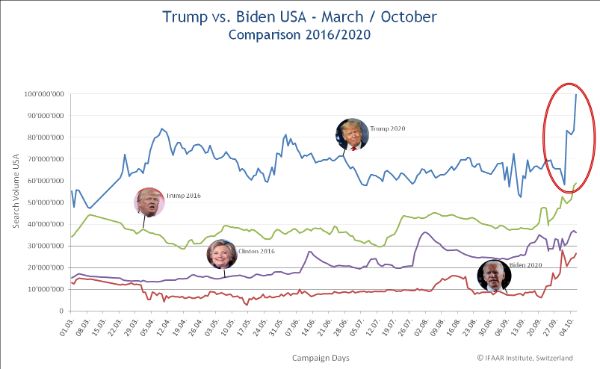Trump’s Corona: Highest Search Volume
Swiss computer scientists measure more than 100 million searches for Donald Trump
The worldwide media echo on Donald Trump’s Tweet of October 2nd has boosted his campaign in the US like never seen before. A group of Swiss computer-, big data- and political scientists are analyzing the public online campaign on all US search and social media channels again, similar to 2016. The real time measures of the searches of 247 million active users on all US online channels show, that the announcement of Donald Trump being infected by the Corona virus had an all-time high impact, also on his digital campaign: 100’559’000 on average monthly search volume on all US channels, whereas Joe Biden only made it up to 26’594’000.

The almost real time figures of the whole campaign show, that this year’s US elections are basically a referendum for or against Donald Trump and that the Biden campaign didn’t even come close to Hillary Clinton’s search volume of 2016! “The presence on the Internet and the active involvement of users is extremely important, if one wants to win an election in the US”, says Christoph Glauser, one of the election experts and Swiss political- and digital data scientist.
The Biggest “digital advertising” ever
This tweet is worth more than a billion dollars if it would be spent on digital advertisement. If the corona announcement of Donald Trump in his tweet would have been a paid digital advertising campaign, not even Larry Page and Sergey Brin (Google), Mark Zuckerberg (Facebook), Jeff Bezos (Amazon) and Bill Gates (Microsoft) could have put together enough money for such an advertising impact. More than one hundred million active searches on all online channels. “This is outstanding” says Jacques Savoy, computer science professor at University of Neuchâtel in Switzerland. Since the invention of the world wide web, by Tim Berners Lee in Switzerland in 1993, the scientists of the Swiss monitoring project team have never seen a peak like this before on their multinational search volume data. Donald Trump was actually losing attention after the republican convention, whereas Joe Biden finally managed to gain at least some attention by the beginning of September. Donald Trump desperately needed a boost for his campaign - the corona virus has delivered the boost for him, as the most recent campaign data show now:

Search volume analysis
Thanks to new innovative technologies, the project UMUSE2* identifies the number of average search requests sent in the US to all search engines, social media and e-shops, with the names of the two candidates, namely “Donald Trump” and “Joe Biden”, but also with all the topics high on search surrounding the election year. Based on these figures, Donald Trump had a significant lead over his rival. During the whole campaign, Joe Biden's popularity has seen a short surge with the announcement of running mate Kamala Harris and later on starting in the “hot phase” of the campaign at the beginning of September 2020. The scientific big data analysis shows, that 247 million active Internet users on all US channels have actively reacted on Donald Trump’s corona announcement on Twitter and on the following giant media coverage.
On Twitter
On Twitter too, Trump presents a more visible profile sending more than 43 tweets per day (September) and having more than 87 million followers. Biden writes around 11 tweets per day (September) for around 10.7 million followers. When looking at the stylistic aspects, Trump tends to retweet more (35% of his tweets). He also uses the pronouns “I” and “you” more frequently to establish a link with the reader. Biden opts for the “we/our” formulation in order to imply the audience more (together, we will build).
When studying the tweets’ contents, both candidates frequently use general political terms. In addition, Trump invokes the “fear” of Democrats winning the election, while Biden puts forward “values” (e.g., honesty, love) and the consequence of covid-19. Moreover, important political topics were mainly ignored such as education, immigration, liberty, rights, or justice. For example, the term “education” appears only three times during August and September.
The authors:
Christoph
Glauser (1), Jacques Savoy (2), Loris Schmid
(1,2)
1 IFAAR, Bern
2 Computer Science
Dept., University of Neuchatel
University of Neuchatel has a long tradition in computational linguistics with a team composed by Prof. Jacques Savoy and Loris Schmid (natural language processing) http://www.unine.ch/iiun.
The IFAAR Institute in Berne Switzerland has ten years of expertise in search & find software development and new media evaluation research, and is represented by Dr. Christoph Glauser (political- digital- and mass media scientist https://ifaa.ch. This computer science research project has been financially supported, in part, by Hasler Foundation (Berne).
Any opinions, findings, conclusions, and/or recommendations are meant for mere scientific research purposes only and are not intended to support any political views or campaigns.
*User Monitoring of the US Elections (UMUSE2).


 UN Department of Global Communications: Global Growth To Remain Subdued Amid Lingering Uncertainty, Warns UN Report
UN Department of Global Communications: Global Growth To Remain Subdued Amid Lingering Uncertainty, Warns UN Report Patrick Decloitre, RNZ: Alcide Ponga is New Caledonia’s new president
Patrick Decloitre, RNZ: Alcide Ponga is New Caledonia’s new president Jimmy Videle, IMI: Guide To Preserving Sacred Land Near You
Jimmy Videle, IMI: Guide To Preserving Sacred Land Near You World Economic Forum: Future Of Jobs Report 2025 - 78 Million New Job Opportunities By 2030 But Urgent Upskilling Needed To Prepare Workforces
World Economic Forum: Future Of Jobs Report 2025 - 78 Million New Job Opportunities By 2030 But Urgent Upskilling Needed To Prepare Workforces Pasifika Medical Association: PACMAT Continues Efforts In Vanuatu Earthquake Response
Pasifika Medical Association: PACMAT Continues Efforts In Vanuatu Earthquake Response Global Jews for Palestine: Call From Jewish Groups Across The Globe: Tell Your Political Representatives Now- UNRWA Is Urgent
Global Jews for Palestine: Call From Jewish Groups Across The Globe: Tell Your Political Representatives Now- UNRWA Is Urgent